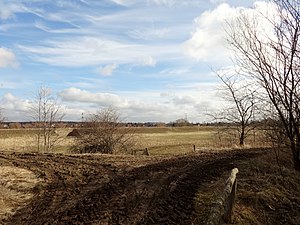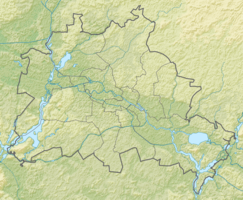Falkenberger sewage fields
|
Falkenberger sewage fields
|
||
|
Former Berlin Rieselfelder |
||
| location | Berlin-Falkenberg , Germany | |
| Identifier | FFH-05 / NSG-30 | |
| WDPA ID | 163020 | |
| Natura 2000 ID | DE3447301 | |
| FFH area | 84.2 ha | |
| Geographical location | 52 ° 35 ' N , 13 ° 33' E | |
|
|
||
| Setup date | March 29, 1995 | |
The Falkenberger Rieselfelder is an 84.2 hectare nature reserve and Natura 2000 area in the Berlin district of Falkenberg in the Lichtenberg district .
history
At the end of the 19th century, City Councilor James Hobrecht laid out large sewage fields in the Berlin area and built a sewer system . On the sewage fields, the city's wastewater was cleaned by trickling . The sludge completely dried out due to seepage , the valuable fertilizer that was extracted from it was used for the sewage fields and the sandy and nutrient-poor soil was used for growing grain and vegetables . The sewage fields, which are now used as a nature reserve, were built around 1884. In the 1950s and 1960s it became known that the wastewater was increasingly polluted with pollutants. In 1968 a sewage treatment plant was put into operation in Falkenberg , after which the sewage fields were no longer needed. On March 29, 1995 the Falkenberger Rieselfelder was placed under nature protection. In the protected area, remains such as trickle and seepage basins, ditches and hedges can still be seen.
Design
The area is bordered in the south by the Zehnrutenweg as part of the Barnim Dörferweg , in the west by the Berllpfuhl and in the east by the Millions Trench , a large main drainage ditch. To the north the border with the state of Brandenburg forms the end. The nature reserve is divided into two areas by the Koppelgraben, which runs in the middle from northwest to southeast . In the upper, north-western part there is a small deciduous forest, which is surrounded by herbaceous vegetation . This is followed by a paddock to the east. The southern part is characterized in particular by a spacious paddock where Heck cattle are cultivated.
fauna and Flora
Nine of a total of twelve amphibian species occurring in Berlin have been recorded in the area, including the crested newt and the fire-bellied toad . These two types resulted in the nature reserve in the EU -Netz Natura 2000 was recorded. Furthermore, visitors can observe common toads , green toads , but also garlic toads and moor frogs . For them, individual depressions were deepened in order to absorb the strong fluctuations in water that occur in the protected area. Depending on the water level, the red-necked grebe , but also gray geese, can be observed.
In addition to the amphibians that nest in the area Skylark , the Corn Bunting , the whinchat that stonechat and the quail and lapwings . For the now also native to Buzzard , the Senate turned on wooden poles to support the Raptor at his hunting.
Web links
Individual evidence
- ↑ 3447-301 Falkenberger Rieselfelder. (FFH area) Profiles of the Natura 2000 areas. Published by the Federal Agency for Nature Conservation . Retrieved November 28, 2017.
- ↑ Falkenberger Rieselfelder nature reserve on stadtentwicklung.berlin.de



